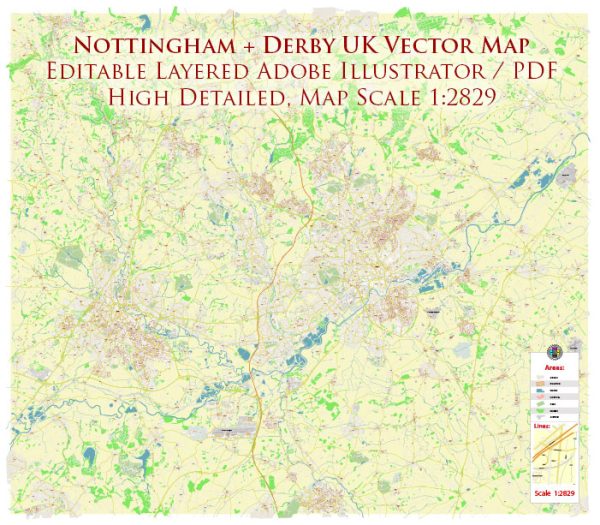The history of urban development in Nottingham and Derby, two cities in the East Midlands region of the United Kingdom, is marked by a combination of industrial growth, economic changes, and social transformations. While each city has its unique story, they share some common trends in their historical development.
Nottingham:
Medieval and Early Modern Periods:
- Medieval Origins: Nottingham has ancient origins, with evidence of settlement dating back to Roman times. The city’s medieval castle played a significant role in its development.
- Market Town: Nottingham grew as a market town, benefiting from its central location in England and the River Trent’s navigability, which facilitated trade.
Industrial Revolution:
- Textile Industry: In the 18th century, Nottingham became a center for the textile industry, particularly lace and hosiery. The Industrial Revolution brought significant economic changes and population growth.
- Canals and Railways: The construction of canals and railways enhanced transportation, connecting Nottingham to other industrial centers and facilitating the movement of goods.
20th Century:
- Diversification of Industry: In the 20th century, industries diversified, with manufacturing and services playing vital roles. The city faced economic challenges in the mid-20th century as traditional industries declined.
Modern Era:
- Regeneration: Nottingham underwent urban regeneration efforts in the late 20th and early 21st centuries. The city center saw redevelopment projects, including the expansion of shopping areas and improvements in infrastructure.
Derby:
Industrial Revolution:
- Early Industrialization: Derby played a crucial role in the early stages of the Industrial Revolution. It was a center for silk and cotton spinning, and the establishment of the Derby Silk Mill in 1721 is considered a landmark in industrial history.
Rail and Engineering:
- Railway Hub: In the 19th century, Derby became a significant railway hub, with the establishment of the Midland Railway. This contributed to the city’s growth and economic prosperity.
- Engineering Heritage: Derby has a strong engineering heritage, with companies like Rolls-Royce and the Derby Locomotive Works shaping its industrial landscape.
Post-War Period:
- Post-War Reconstruction: Like many industrial cities, Derby faced challenges post-World War II, with the need for reconstruction and redevelopment. The aerospace and engineering industries continued to play a key role.
Contemporary Developments:
- Economic Diversification: In recent decades, both cities have experienced economic diversification, with a shift towards the service sector and advanced manufacturing.
Shared Characteristics:
- Transportation: The connectivity provided by the River Trent, canals, and railways has been crucial for the development of both cities.
- Urban Regeneration: Nottingham and Derby have undergone urban regeneration projects to revitalize city centers and adapt to changing economic landscapes.
- Diversification: Both cities have transitioned from being predominantly industrial to embracing a more diverse economic base.
The history of Nottingham and Derby reflects the broader narrative of industrialization, economic transformation, and urban evolution that characterizes many cities in the United Kingdom.


 Author: Kirill Shrayber, Ph.D.
Author: Kirill Shrayber, Ph.D.